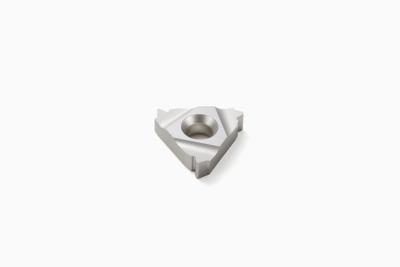
With the introduction of 13 new full-profile threading inserts, Seco Tools now offers a full range of UNJ and MJ thread profiles for both external and internal applications. Shops that need to generate high-precision threads in stainless steels and heat-resistant nickel-based and titanium alloys will benefit from the extremely tight-tolerance profiles of these inserts.
Manufacturers, especially those in the aerospace sector, can now extend tool life while eliminating process inconsistency and profile inaccuracy with these new inserts that are part of an all-encompassing range of threading solutions from Seco.
Hazardous, tangled curly chips can stall threading production, but the new inserts pair with Seco holders featuring the company's Jetstream Tooling high-pressure directed coolant technology that keeps the cutting zone clear. To guide and steer chips in specific directions away from the cutting zone, these holders deliver a concentrated high-pressure, high-velocity jet of coolant directly to the ideal position close to the cutting edge.
Threading titanium and similar materials produces tough chips that decrease tool life. With the improved chip control of Jetstream Tooling, shops can use 30 percent to 60 percent higher cutting speeds without compromising thread surface quality.
UNJ thread profiles produce inch threads; MJ profiles handle the corresponding metric versions.
Contact Details
Related Glossary Terms
- alloys
alloys
Substances having metallic properties and being composed of two or more chemical elements of which at least one is a metal.
- coolant
coolant
Fluid that reduces temperature buildup at the tool/workpiece interface during machining. Normally takes the form of a liquid such as soluble or chemical mixtures (semisynthetic, synthetic) but can be pressurized air or other gas. Because of water’s ability to absorb great quantities of heat, it is widely used as a coolant and vehicle for various cutting compounds, with the water-to-compound ratio varying with the machining task. See cutting fluid; semisynthetic cutting fluid; soluble-oil cutting fluid; synthetic cutting fluid.
- stainless steels
stainless steels
Stainless steels possess high strength, heat resistance, excellent workability and erosion resistance. Four general classes have been developed to cover a range of mechanical and physical properties for particular applications. The four classes are: the austenitic types of the chromium-nickel-manganese 200 series and the chromium-nickel 300 series; the martensitic types of the chromium, hardenable 400 series; the chromium, nonhardenable 400-series ferritic types; and the precipitation-hardening type of chromium-nickel alloys with additional elements that are hardenable by solution treating and aging.
- threading
threading
Process of both external (e.g., thread milling) and internal (e.g., tapping, thread milling) cutting, turning and rolling of threads into particular material. Standardized specifications are available to determine the desired results of the threading process. Numerous thread-series designations are written for specific applications. Threading often is performed on a lathe. Specifications such as thread height are critical in determining the strength of the threads. The material used is taken into consideration in determining the expected results of any particular application for that threaded piece. In external threading, a calculated depth is required as well as a particular angle to the cut. To perform internal threading, the exact diameter to bore the hole is critical before threading. The threads are distinguished from one another by the amount of tolerance and/or allowance that is specified. See turning.

